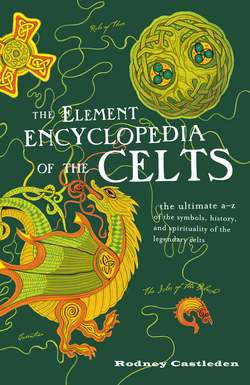Читать книгу The Element Encyclopedia of the Celts - Rodney Castleden - Страница 8
PEOPLE WE KNOW
ОглавлениеSometimes we think of that early world of the Celts as being an anonymous tribal world, a place where we know no one. In fact we know a surprisingly large number of people who lived in that world and we will be meeting some of them in the first section of this book.
There were several kings in Britain whose names are known: Cassivellaunus (or Caswallawn), Cunobelin (or Cymbeline), Caratacus, Cogidumnus, Cartimandua the client queen of the Brigantes, Boudicca the warrior queen of the Iceni, Diviciacus the Druid king who visited Rome and befriended Cicero, and Vercingetorix the heroic Gaulish king who surrendered to Caesar rather than see his horses, or any more of his companions, killed. A few centuries later we stumble upon St. Patrick, St. Columba, and the ever-mysterious, ever-elusive figure of King Arthur.
Arthur has somehow moved across from history to myth, acquiring the character of a Celtic god along the way, and some of the mystification surrounding his life may reflect the religious beliefs of the time. Another section of this book is devoted to these beliefs.
The spirit world was integrated into the everyday Celtic world in a way that it no longer is today. There was no separation between the people and the spirits: the gods and goddesses who inhabited and controlled everything. The spirits were seen as residing within the natural features of the landscape. Every hill and headland, and every stream and spring, every forest and marsh had its own in-dwelling spirit. Worship was a matter of communing with the spirits in the places where they lived. People went to riverbanks to commune with the spirits of the river. They went to springs to commune with the sprites who looked after those magic places where life-giving water seeped out from the Underworld. There were temples and shrines, but a great deal of the mediation between the everyday world and the spirit world went on out in the landscape, in the open air.
Another section of this book looks at places that have special associations with the Celts: their settlements and strongholds, the scenes of their famous victories and defeats in battle, their sanctuaries and cult places.
There is also a section about the symbols and archetypes that underpin the culture of the Celts and another looking at a selection of their myths, legends, and folktales; the Celts have always been great storytellers.
The final section is a brief overview of the last thousand years or so of Celtic history, which falls into two halves. One is a phase of suppression and eclipse which I call the “Celtic twilight.” The second is a phase of rediscovery and re-emergence—the “Celtic revival”—which brings this review of the Celts up to the present day.
To go back to the beginning, the origin of the people first named the Celts by classical writers has long been the subject of speculation and discussion. The Celts of the Iron Age have an aura of mystery about them because, like the Minoans, they did not leave us any written literature of their own. There are some inscriptions and a fragmentary calendar, but there is no literature as such. The ancient Celts, either deliberately or inadvertently, surrounded themselves with mystery, like the hero Caswallawn with his magic plaid of invisibility.
Who were they? It is a question we are going to come back to again and again, and it is not an easy one to answer. BBC Wales has posted a Celts “factfile” on its educational website aimed at children. The first question is: “Who are the Celts?” It is answered by a simple timeline showing five blocks of time: “STONE AGE” (to 2000 BC), “BRONZE AGE” (to 600 BC), “IRON AGE CELTS” (to AD 50), “ROMANO-BRITISH” (to AD 400), followed by “CELTS OF TODAY.” There are two cartoon Celts: one wearing a helmet and waving a sword, for the Iron Age, and one wearing a yellow shirt and blue tracksuit bottoms for today. So, according to BBC Wales, “Celt” has two senses, describing a group of people today and another group of people 2,000 years ago. Then a link between them is made: “Their culture lives on in language, music, song, and literature.”
One of the questions this book needs to address is how far that is true. Is the Celticness of today really the same as that of 2,000 years ago?
